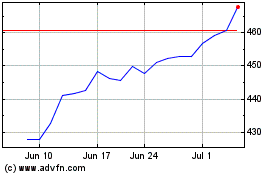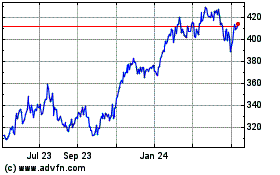Microsoft's New Privacy Dashboard Lets You Delete Personal Data
January 11 2017 - 6:59PM
Dow Jones News
By Nathan Olivarez-Giles
If you use an Xbox, Windows 10, Skype, Bing or other Microsoft
Corp. products, the company is collecting some data on you. After
years of inconsistent privacy settings, there's now a dashboard
that provides more transparency and control over your histories and
personal information.
The new online tool -- account.microsoft.com/privacy -- is the
first step in a two-part initiative. The second is due this spring,
when a significant Windows 10 update brings more granular privacy
settings.
"We want you to be informed about and in control of your data,
which is why we're working hard on these settings and controls,"
said Terry Myerson, vice president of Microsoft's Windows and
Devices Group, in a blog post. "Regardless of your data collection
choices, we will not use the contents of your email, chat, files,
or pictures to target ads to you."
The dashboard is similar to a website that Alphabet Inc.'s
Google introduced last July. Both provide a single jumping-off
point for seeing what data the company is collecting on you. In
some cases it gives you centralized controls; in others it links to
other product-specific privacy pages.
Microsoft's dashboard lets you see your Edge browser history,
your Bing search history and your Cortana preferences (aka
"Cortana's Notebook"). While you can see these entire histories,
you only have the option of keeping them or deleting them
wholesale. This is far less helpful than Google's tool, which lets
you remove specific searches and sites individually.
For services such as Xbox, Skype, Office and the HealthVault
health data manager, as well as data tracked for Microsoft's ads
and marketing business, the dashboard simply links you to other
websites. In some instances, you can easily remove data, in others,
you can only review it.
You also can't manage Windows 10 privacy settings on this new
dashboard. Those settings, built into the OS, will become simpler
to use following this spring's Creators Update, Microsoft says.
Users will be able to opt out of location tracking, speech
recognition, and personal data being used to create "relevant ads."
If you use Windows 10, you can't opt out of Microsoft's diagnostic
data collection, which monitors what apps you have installed, for
instance. But you will be able to step down from "full" sharing to
"basic" sharing, so that it will no longer collect data on your
typing, your OS feature use and some other areas.
Write to Nathan Olivarez-Giles at
Nathan.Olivarez-giles@wsj.com
(END) Dow Jones Newswires
January 11, 2017 18:44 ET (23:44 GMT)
Copyright (c) 2017 Dow Jones & Company, Inc.
Microsoft (NASDAQ:MSFT)
Historical Stock Chart
From Mar 2024 to Apr 2024

Microsoft (NASDAQ:MSFT)
Historical Stock Chart
From Apr 2023 to Apr 2024
